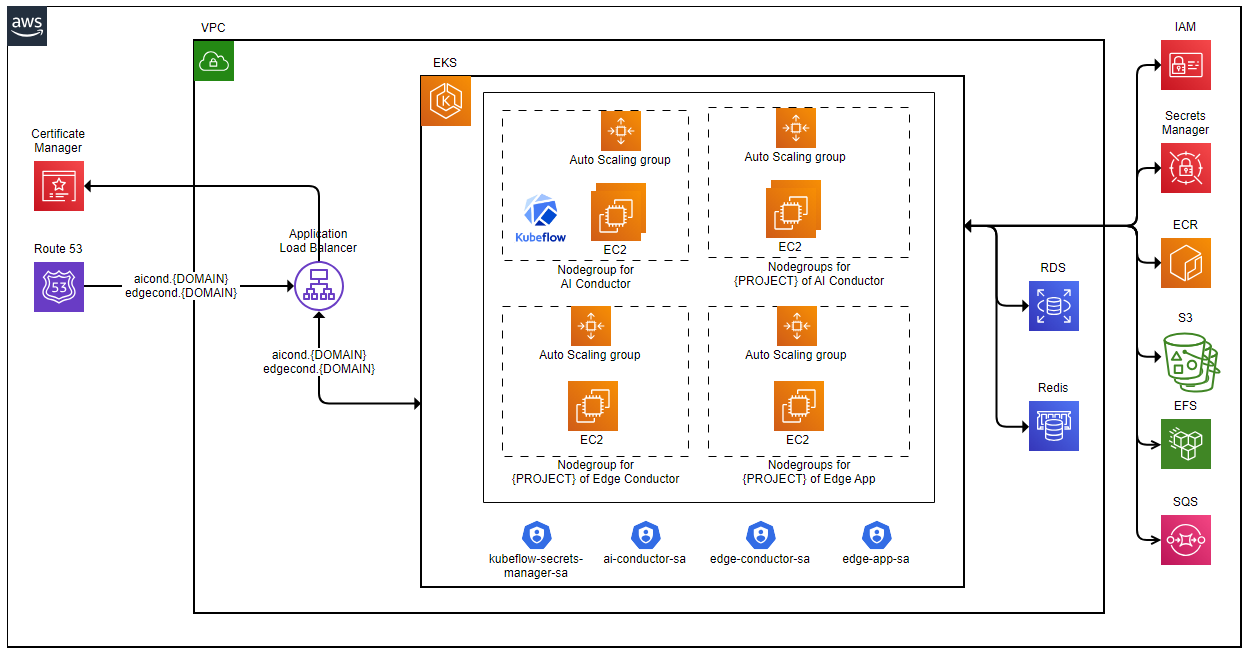Infrastructure Setup
This manual provides guidance on the AWS cloud infrastructure for Mellerikat. To understand the overall architecture, please refer to the provided video. Afterward, follow the instructions in this manual to proceed with the installation process. This will allow you to effectively utilize Mellerikat's AWS-based infrastructure.
The infrastructure is designed to run Edge Conductor and Edge App in a cloud environment. Depending on user requirements, these components can also be installed and operated in an on-premise environment.

Mellerikat Infrastructure (AWS-based)
| INFRA | DESCRIPTION | NOTE |
|---|---|---|
| DOMAIN | Access address for AI Conductor and Edge Conductor - If an existing address is available, skip installation. | mellerikat-{COMPANY_NAME}.com |
| Load Balancer | Install an Application Load Balancer. | Scheme: Internet-facing Set Listener Rules for: - AI Conductor Backend - AI Conductor Frontend - Kubeflow Dashboard |
| VPC | Install a Virtual Private Cloud (VPC). | Subnet: Use Availability Zones "a" and "c" CIDR: Set to 10.0.0.0/16 |
| EKS | Install AWS-managed Kubernetes (EKS). | Version: 1.28 |
| NodeGroup | Install a node group for operating AI Conductor. | Instance type: m5.2xlarge (recommended) Desired size: 2 Min size: 1 Max size: 3 |
| RDS | Install MySQL. | Engine Version: MySQL 8.0.33 (recommended) Instance type: db.m5.large (recommended) Availability and durability: Multi-AZ DB instance Subnet Group: Use Availability Zones "a" and "c" Port: 3310 |
| ElastiCache | Install Redis. | Engine Version: 7.1 Node type: cache.m6g.large (recommended) / cache.t4g.small (minimum) Cluster mode: Disabled Multi-AZ: Enabled Encryption in transit: Enabled Port: 6379 |
| Secrets Manager | Use AWS Secrets Manager for S3 and RDS access in Kubeflow. | - S3 Access Secrets - RDS Access Secrets |
| S3 | Create operational buckets. | - Mellerikat operational bucket - Kubeflow operational bucket |
Project-Specific Infrastructure (AWS-based)
| INFRA | DESCRIPTION | NOTE |
|---|---|---|
| Load Balancer | Add listener rules to the installed Application Load Balancer. NOTE: Only required if Edge Conductor is cloud-based. | Initial setup for Edge Conductor: - Edge Conductor Backend - Edge Conductor Frontend |
| NodeGroup | Add a node group to the existing EKS cluster for project operation. NOTE: Only required if Edge Conductor is cloud-based. | Edge Conductor: - Instance type: m5.2xlarge - Desired size: 2 - Min size: 1 - Max size: 3 AI Conductor: Install based on training needs |
| S3 | Create a project-specific S3 bucket. | Project operational bucket |
User Scenario
Here’s a typical user workflow for setting up infrastructure:
-
Environment Analysis: The data engineer analyzes the deployment environment for the AI Solution and defines installation requirements for Edge App, Edge Conductor, and AI Conductor. This includes thoroughly identifying user requirements and ensuring compatibility with the operational environment.
-
Architecture Design: The engineer designs and builds an optimized architecture that takes into account the functions and requirements of each component. For example, Edge App can be installed on Splunk Edge Hub, NVIDIA Jetson Nano, an on-premise WSL environment, or in the cloud.
-
Component Installation: Install Edge App, Edge Conductor, and AI Conductor on the designed infrastructure. During Edge App installation, configuration must include connection details for Edge Conductor.
-
System Integration: If existing MLOps systems (e.g., SageMaker) are in use, configure integration to ensure seamless service interoperability with Mellerikat components.
-
Optimization and Monitoring: Optimize the Mellerikat-based MLOps platform and continuously monitor system performance. Promptly address any performance issues to ensure reliable system operation.